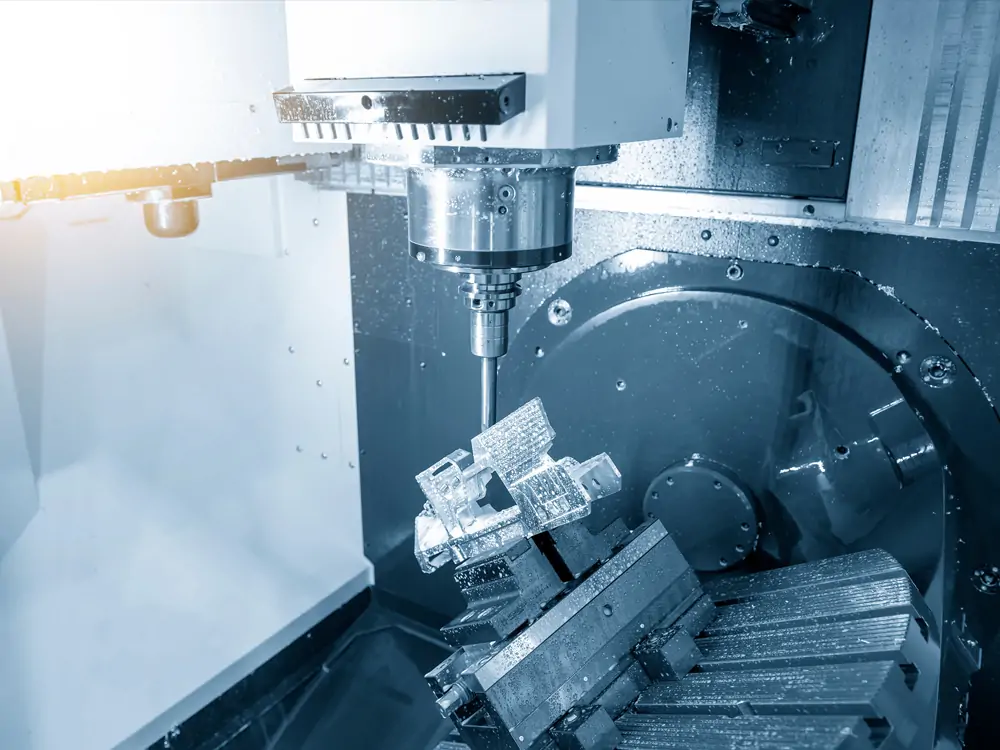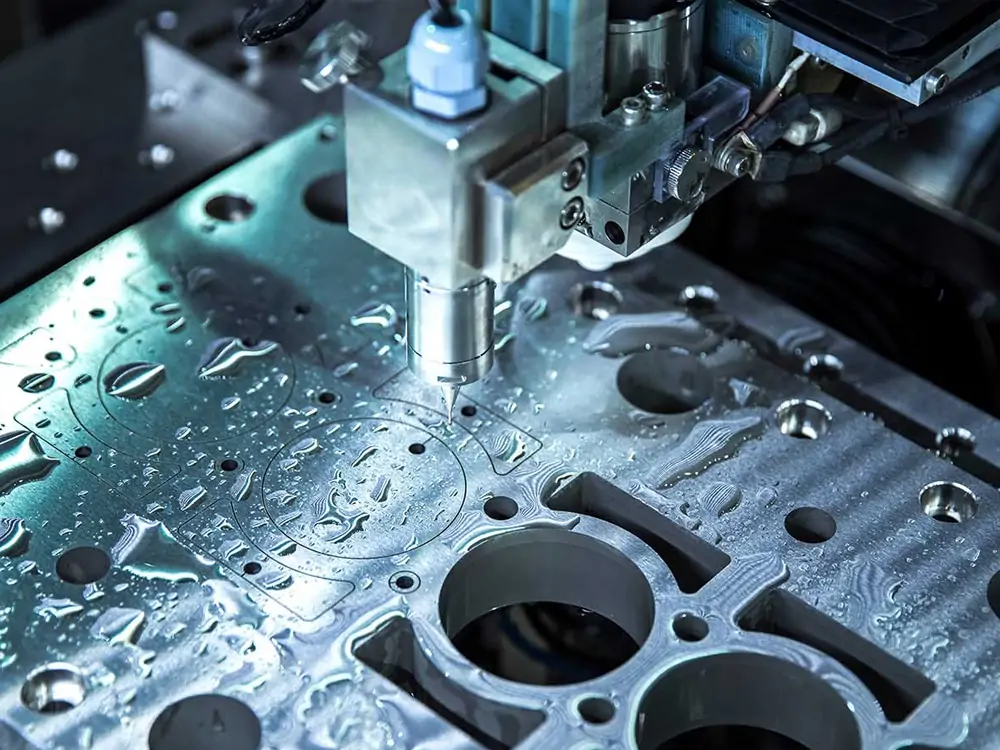- Published on
What is CNC Machining? Definition, Process, Benefits
- Authors

- Name
- William Smithson
CNC machining means computer numerically controlled machining. It is an advanced technology that is changing the dynamics of production. Not only that, but it is a process that uses computer-driven machines. It forms raw materials into complex products and molds them. The method achieves unparalleled accuracy.
What is a CNC Machine?

A CNC machine is simply a machine equipped with CNC technology and capabilities. The primary purpose of a CNC is to regulate a machine tool's movements. A computer, computer-aided manufacturing (CAM) program, and digitized data combine to monitor, control, and automate the movements of CNC equipment.
Each CNC controller collaborates with many motors and drive elements to carry out and regulate the preprogrammed motions. A feedback system continuously analyzes and modifies the cutter's location, feed rate, and speed on more advanced machines.
Types of CNC Machines

CNC machines come in different types. A particular manufacturing need suits each one. They offer versatility and precision in many uses. Understanding these machines is crucial. It helps improve production efficiency. Let us explore some of the most popular varieties of CNC machines:
CNC Mills
These types precisely shape a workpiece to the necessary dimensions by removing material using cutting tools. Various cutting tools, each serving a distinct function, can be found in CNC mills. Drills, taps, end mills, reamers, and face mills are common cutting tools. There are variations of these machines that are horizontal and vertical. They work in industries such as automotive, aerospace, etc.
You might be surprised to learn that a CNC milling machine can cost more. Many less expensive alternatives are available for general use, starting at 200,000.
CNC Lathes
CNC lathes function by revolving the material around an axis in the center. After that, the workpiece is cut with tools to remove the material and mold it into the desired shape. Compared to manual lathes, a CNC lathe machine can produce the resulting product faster and more precisely.
CNC lathe makes things in practically every industrial industry. It can make baseball bats, car parts, gun barrels, crankshafts, and camshafts.
CNC Routers
On flat surfaces of any material, CNC routers can cut a variety of forms and designs. These devices replace manual instruments like panel saws, spindle molders, and boring machine tools. The initial cost of a CNC router typically ranges from 100,000. The hourly prices for CNC mills and routers are the same. Due to its ability to cut, it is used in Carved wood furniture, Mouldings, Interior and exterior decorations, etc.
CNC Plasma Cutters
The CNC plasma cutter equipment produces incredibly precise cuts. An electrical discharge arc ionizes the air and melts the material it impacts. The procedure only applies to electrically conductive materials since it operate via an electrical arc. The initial cost ranges from 300,000. The hourly cost of a plasma cutter is $20.
CNC Laser Cutters
They can cut sheets of any material. They utilize a highly concentrated laser beam. A laser cutter is even more precise than a plasma cutter. Solid-state lasers can cut through any material, so CNC laser cutters are not just for conductive materials.
Applications of CNC Laser Cutters are in making Aerospace parts, Medical Equipment, Automobile frames, etc. A laser-cutting machine can range from 300,000. These machines have an hourly cost of around $20.
CNC EDM Machines
Like plasma cutters, an Electrical Discharge Machine (EDM) removes material at the desired place through an electrical arc. This technique may produce quick 2D cuts by using a metal sheet format. Applications of CNC electrical discharge machines are die casting, injection mold making, prototyping, etc.
CNC Press brake
A CNC press brake machine is a mechanical tool powered by an electrical system. This permits precise and accurate bending of raw material. In the production sector, CNC press brake machines are incredibly helpful instruments. The Press Brake machine yields superior quality work with twice the precision and faster outcomes.
CNC Shearing Machine
A CNC shearing machine is a technical device that uses numerical instructions of text, symbols, and numbers to control the movement of one or more shearing machine components. Developing binary data operations and data carriers is necessary to evolve CNC shearing machines. Numerical control plate shears are typically operated by specialized computers.
How does CNC Machining Work?

CNC machining means Computer Numerical Control machining. CNC machining is the magic of high technology. It applies computers to run the machines that produce objects with extreme precision. It is a really great technique to automate the production of customized parts.
To turn the CNC machine, you type codes into the computer. The computer reads this code and orders the tools to form things. Thus, unlike the old machines with punch cards, CNC employs keyboards for efficient programming.
If the codes are error-free, then CNC is brilliant. However, mistakes may occur occasionally, especially in specific complex cuts. CNC programming is adaptive in that changes and additions can be made to the machine's working.
It is said to take place in the computer's memory because all instructions are usually stored there. This is much more superior to the old punch cards. CNC machine work has revolutionized the technology as it provides accuracy, automation, and flexibility in manufacturing.
What is a CNC System?
To make things, the CNC is a highly intelligent machine. It is a cooperation between computers and machines. This team is very capable of interpreting the designs to produce the measurements. These instructions direct the CNC processing machines to cut, shape, or carve materials.
Components of a CNC System
Input Devices:
The CNC machine receives the part program from these devices. Punch tape readers, magnetic tape readers, and computers with RS-232-C connectivity are the three types of input devices that are frequently utilized.
Machine Control Unit (MCU):
The MCU controls all CNC machine operations as its central component. Its duties include reading the coded instructions, decoding them, generating axis motion commands by linear, circular, and spiral interpolation, and executing auxiliary control operations like tool changes and coolant or spindle on/off.
Machine Tool:
A spindle and a sliding table make up the CNC machine tool to regulate position and speed. The spindle is controlled along the Z axis, and the machine table is controlled along the X and Y axes.
Driving System:
Ball lead screws, drive motors, and amplifier circuits make up the driving system. The MCU feeds each axis' position and speed signals to the amplifier circuits, which amplify the control signals to turn on the drive motors.
Feedback System:
Transducers are used in this system to function as sensors and measurement tools. It constantly keeps track of the cutting tool's position and speed.
Display Unit:
CNC machine programming, commands, and other relevant data are shown on a monitor that serves as a display unit.
Benefits of CNC Machining
Some benefits of CNC systems are:
Reduction in Cost
CNC machines are cost-effective. They reduce production costs through precision manufacturing. Energy consumption is reduced due to enhanced production efficiency, scalability, and less material waste. This results in cheaper operating costs. The weight of potential financial liabilities associated with worker safety is also reduced. This helps in cost-cutting.
Waste reduction
Due to repeated refinements, the software used to operate various CNC machines generates little waste during manufacturing.
Enhanced Safety
CNC machines reduce the likelihood of accidents and ensure worker safety because there is less need for human intervention. The latest CNC machines are self-contained. Humans may control them remotely for software upgrades, design revisions, or preventative maintenance.
Reduction of human mistakes
CNC manufacturing enables increased precision, speed, flexibility, and consistency by eliminating human error from the process. In the end, this leads to fewer errors in the manufactured goods.
Contour Machining
One of the features offered by CNC is contour machining. This makes it possible to manufacture curved shapes---including those created by 3D printing and designs.
The Development of Sheet Metal Machine
Industrial cutting, stamping, bending, and forming sheet metal are all done with metal processing machinery. Sheet metal can be bent, pressed, curved, and formed into various sizes and forms using a sheet metal machine.
Numerous technologies, including hydraulic presses, NC control machines, CNC control machines, CNC synchronous machines, and guillotine machines, can also be used to operate sheet metal machines.
Other Methods of Mechanical Processing
CNC machines are great for making things. They are accurate and save time. But there are other ways to do it, too!
Manual Machining
Skilled people use tools like lathes and mills to shape materials by hand. It's suitable for small projects but takes time and effort. Sadly, it's not as precise as CNC machines, which are more precise.
3D Printing
3D printing is incredible for making detailed stuff, but it might not be as perfect or versatile as CNC. It produces smaller, less complex parts made of resin, plastic, or metal.
Waterjet Cutting
This method uses a strong water jet with tiny grains to cut through materials. It's an option, especially for materials that don't like heat. But, it might not be as quick and accurate as CNC.
Stamping and Punching
This method uses special tools, like dies and punches, to cut, bend, and shape materials. It's suitable for making lots of things fast and can be cost-effective. However, CNC might be better for flexibility and precision in some instances.
Electrical Discharge Machining (EDM)
EDM wears away materials using electrical discharges. It's excellent for making molds and dies with precision. However, for making many things, CNC might be more efficient.
Your choice depends on what you need. CNC machines are impeccable in manufacturing. They're accurate, diverse, and efficient. They shine, especially when you need things with tricky shapes.
What Will the Future CNC Machining Process Look Like?
The future of CNC machining looks set to involve a union with the latest tech. The rise of AI will make automation more effective. The machines will adapt in real time. They will streamline processes. New sensors will allow predictive maintenance. IoT integration will make this possible. This will reduce downtime.
Conclusion
CNC machining automates the production process, ensuring that everything is perfect. This allows us to produce material for vehicles and phones.
CNC machines are wonderful. They operate, do not make errors, and manufacture a product. New technologies could make them even more amazing in the future. So, the next time you see a trendy gadget, remember that CNC machining made it awesome.